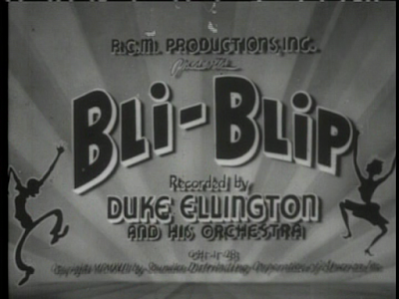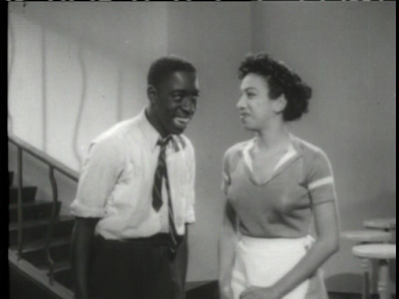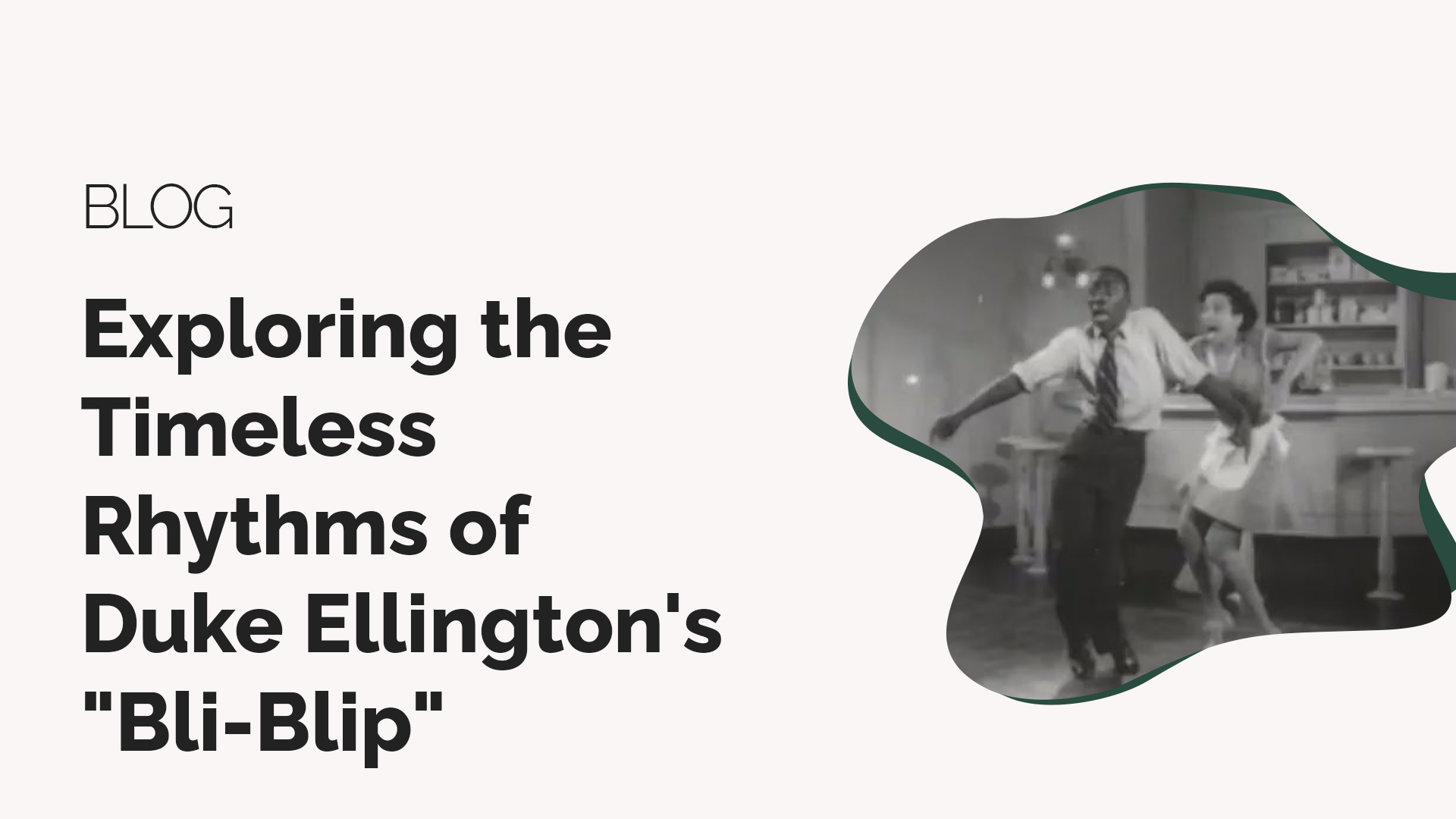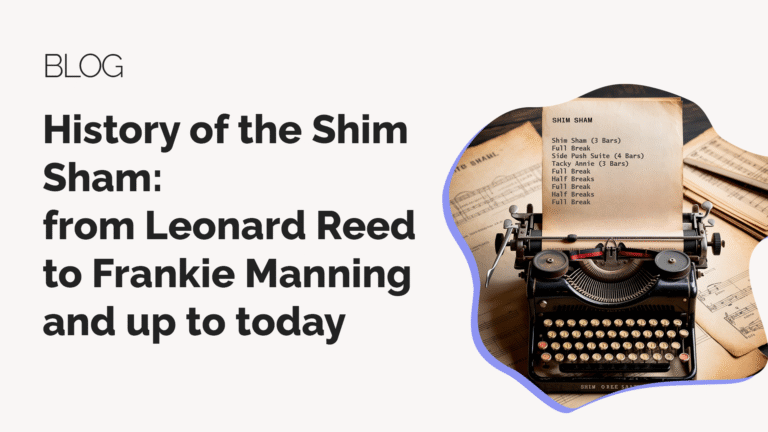Bli-Blip is one of those old gems that not only entertains, but educates us about the rich history of swing music and dance. The soundie showcases the talent of Duke Ellington and his orchestra, together with the dancers Marie Bryant and Paul White.
The Soundie Bli-Blip dance scene (1942), with Paul Whyte and Marie Bryant
This soundie has captivated me for a long time. In the last few months I have been retracing its steps and with the writing of this article I have delved into its history, which I have found fascinating.
I believe in honouring the classics while embracing innovation and creativity. That is why I have adapted the routine ‘Bli-Blip’, to offer my Swing Maniacs students in Barcelona the opportunity to immerse themselves in the magic of Duke Ellington's music and get to know two great dancers, their quality of movement and their expressiveness.
My Swing Maniacs students dancing my adaptation of the Bli-Blip choreo
The learning process and adaptation of the routine was enriching and complicated in equal parts. The pair of dancers dance fast with a lot of tap steps. The job was to understand what they were doing, adapt it to Solo Jazz and give it a personal touch.
When I think of my students, whether you are just starting to dance or you are an experienced dancer, exploring routines like ‘Bli-Blip’ allows you to go straight to the source taking as a reference the Afro-American dancers who created and continued swing dances such as Lindy Hop, Solo Jazz or Tap. I believe in the importance of contextualising the dance and connecting with its rich culture and history.
Ellington and the musical ‘Jump for Joy’.
In 1941 Duke Ellington arrived in Los Angeles from New York when he was already an internationally recognised celebrity but with some financial problems. Ellington travelled with his team (band members, managers, spouses) for an 8-week job, but they did not return to New York for a long time.
In the summer of 1941, Ellington set sail on the creation of a musical revue theatre show which combined social criticism and slapstick. The comedy called Jump for Joy was an ambitious project created with an unorthodox collective of vaudeville gag writers, young black American dancers, and Hollywood instigators such as Charlie Chaplin and Orson Welles.
This musical had two themes close to Ellington's heart: racial pride and progress. The purpose of the show was to eliminate the Uncle Tom* from theatres, removing the stereotypical image that had been exploited by Hollywood and Broadway, and to say things that would make the audience think.
(*‘Uncle Tom’ is a name with negative connotations that refers to black people who are excessively obedient and subservient to whites. It comes from the 1852 novel by Harriet Beecher Stowe “Uncle Tom’s Cabin”.)

The musical featured a cast of 60 artists entirely of African-American origin: comedians, dancers, a chorus line and Ellington's band in the pit. The resulting show had a commercially confusing balance, between comic antics and a serious perspective on equal rights.
Throughout the 122 performances of the musical, some sketches came and went, but "Bli-Blip’ was one of the scenes that lasted forever. If some songs were used to fight for the civil rights of African-Americans, "Bli-Blip" was one of the songs that served as timekeepers for comic antics.
Bli-Blip and the Soundies
In November 1941, two months after ‘Jump for Joy’ had closed, the The Ellington Orchestra recorded the song Bli-Blip in a studio. The same week, the cast met for the final time to record some of the musical pieces in the musical in the Soundie format , one of them being Bli-Blip.
Soundies are three-minute American musical films. which were produced between 1940 and 1946 and are known as the forerunners of music videos. The shorts were originally seen in public places in Panorams: 16 mm coin-operated rear-projection machines that had a glass screen on the outside resembling a large television set. The panorams were usually located in businesses such as nightclubs, bars, restaurants and even factories.
The Soundies are especially important for lovers of swing music and dances because thanks to them we have been able to see African-American artists making music and dancing. They were one of the few mediums in which black artists were free to produce their own films, as the big screen film production companies supported and invested mostly in white artists.
The Soundie Bli-Blip
In the Soundie Bli-Blip appear Marie Bryant and Paul White in a comic and love scene. It is unclear whether the recording matches what was seen at the Mayan Theatre in Los Angeles, but the scene was filmed with the Duke Ellington song recorded in the studio a few days earlier and the actors moving their lips to synchronise with the recording. Marie Bryant was an American dancer, singer, performer and choreographer known for her versatility in various dance styles. Ellington called her ‘one of the best dancers in the world’. Paul White was a great comedian, a skilled dancer and writer. In this scene he complemented the dynamic energy of Bryant and her charismatic presence on stage.


Although, as we have said, ‘Jump for Joy’ was a musical with very important protest elements, Bli-Blip is a scene that is not in the service of racial equality.
The Bli-Blip scene begins with the character played by Paul White mopping the floor and Marie Bryant cashing up in what appears to be a restaurant, dressed in a dress and apron. Both the trades they represent and the facial expressions of both correspond more to the repressed black characters than to the new image Ellington wanted to convey. Beyond the comic vision that we can see in Paul White, with a deeper look and being aware of the history of African-American dancers and the limitation they had to play stereotyped roles, their forced expressions can be a little uncomfortable. Bryant's performance also follows the same rules, although it is a little more subdued.
White often breaks the fourth wall, when singing he looks directly into the camera with wide-eyed wonder, but the highlight of the duet is the instrumental pause where the two stars engage in a talented playful dance around the empty restaurant.
For all these reasons, I think it is important to know the origins and to be able to practice with Bli-Blip as a source of inspiration and enrichment, at the same time that we recognise and value the origins of vernacular jazz.
Further information:
- “Soundies and the Changing Image of Black Americans on Screen: One Dime at a Time” – A book by Susan Delson
- “Marie Bryant” article on Wikipedia
- “Help!: The Beatles, Duke Ellington, and the Magic of Collaboration” de Thomas Brothers
- “Way Out West: Duke Ellington’s Year in Los Angeles” O’Connell, Sean J. California State University, Long Beach ProQuest Dissertations Publishing, 2021.
- ‘A showcase for black talent’: How the spirit and charm of Soundies offer a bittersweet vision of 1940’s America, article from Manohla Dargis
- Uncle Tom article on Wikipedia




